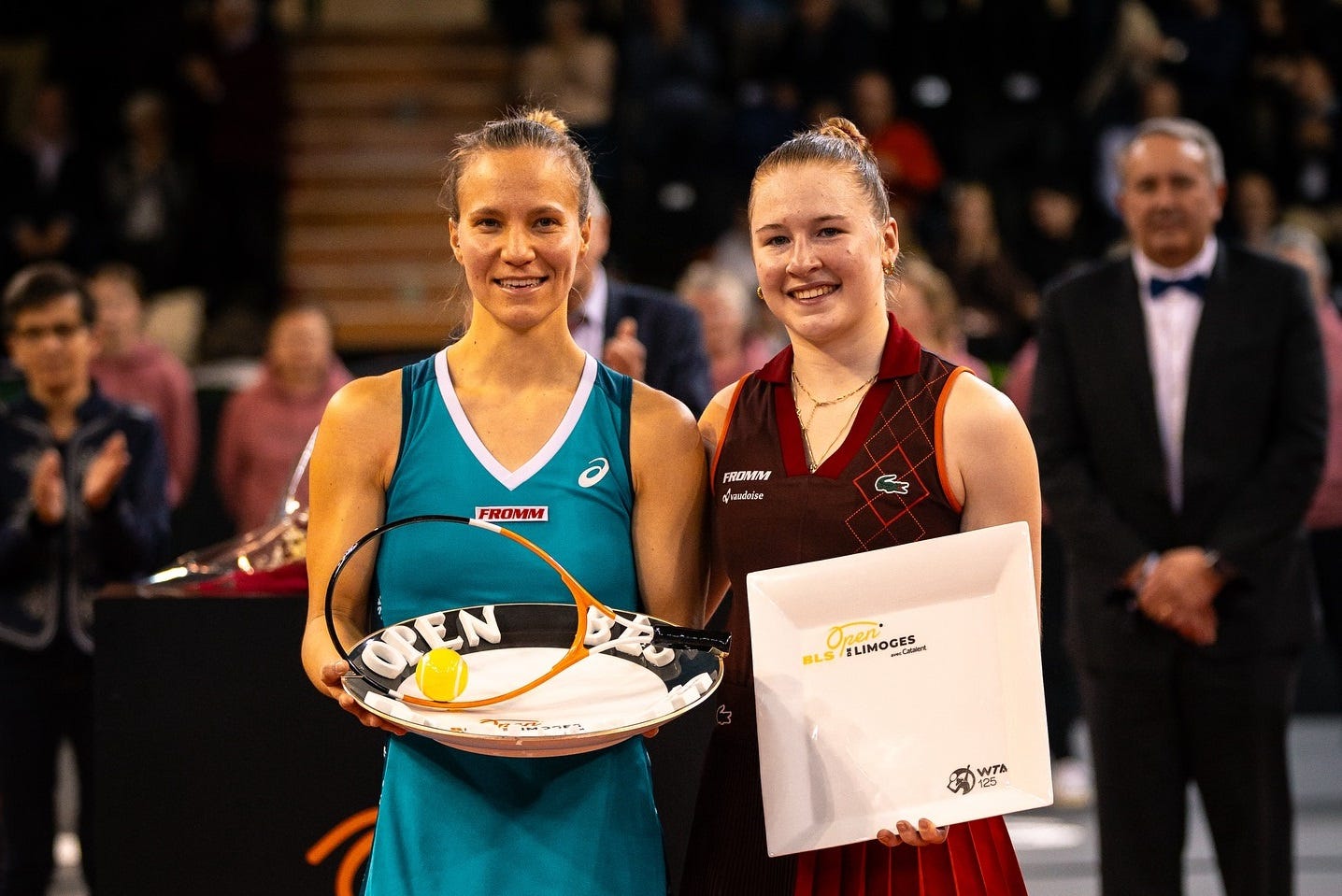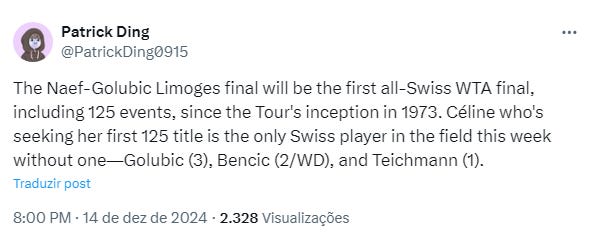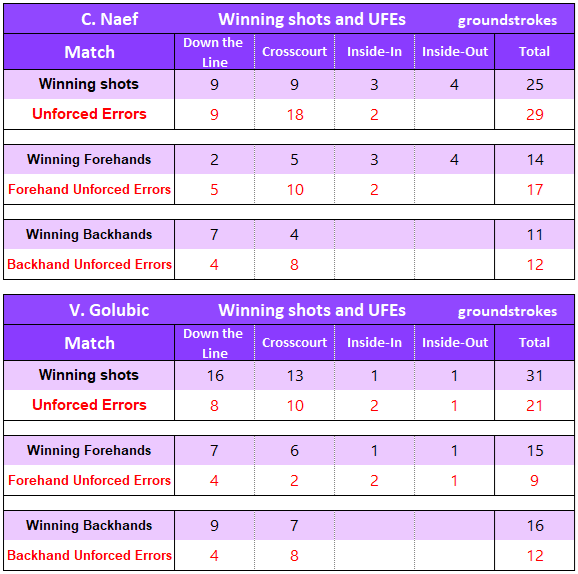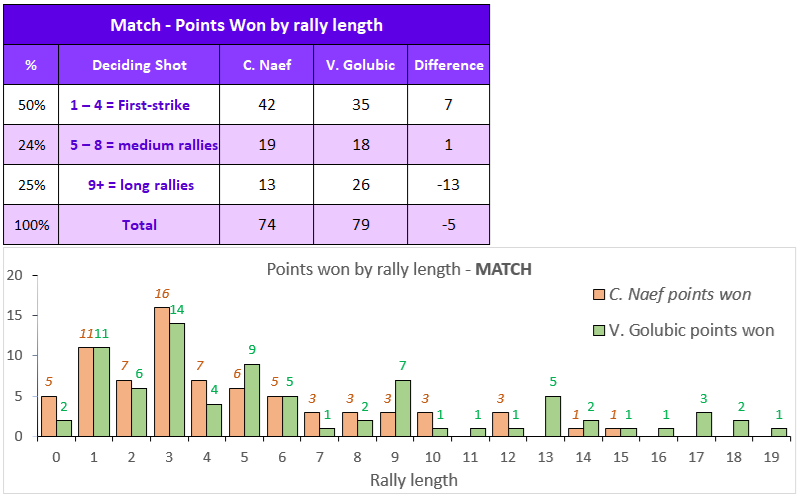Celine Naef vs Viktorija Golubic: Limoges Final Analysis (WTA 125)
Golubic dominated longer exchanges to finish the season on a 12-match winning streak
On the same day the 2025 tennis season officially started, we are dropping the WTA 125 Limoges final analysis to conclude our 2024 season coverage. A total of 124 match analyses, all available in the archive.
For 2025, we are aiming for at least 150 analyses and thrilled to be sharing them with you! Thank you for your interest! Happy Holidays!

Until the end of October, Viktorija Golubic’s year had been lacklustre. Apart from reaching the third round at the Australian Open, she had little else to show for. But there were a couple of events still left on her season and the 32-year-old Swiss made the most out of them.
Winning consecutive Tour-level main draw matches at WTA 250 Jiujiang for the first time since Melbourne reinvigorated Golubic so much that she ended that week clinching her second career WTA title, first in more than 8 eight years.
Two more singles wins during Switzerland’s BJK Cup Play-offs defeat of Serbia meant Golubic arrived for the season finale in Limoges on a 7-match unbeaten run. The streak was one point away from ending in the quarters but Carole Monnet (WTA #244) netted a backhand volley while match point up. Instead, Golubic recovered from 2-5 down in the final set and marched all the way to the Limoges championship match.
With Golubic facing teenage compatriot Celine Naef (WTA #174) in the title decider, a new page in the rich history of Swiss tennis was written.

The all-Swiss Limoges final developed into a tightly-contested match defined by very fine margins. Three points separated players in the first set (40-37 for Golubic) and the difference was even smaller in the second set (39-37 for Golubic). Another example of parity was their equal -15 differential between winners and unforced errors.
A deeper analysis revealed 2 key factors tilting the match towards the more experienced Golubic:
Long-rally dominance
Recurrent rescue of serve games
1. Long-rally dominance
The match featured 39 points reaching 9+ shots. Golubic won 26 of them, with the resulting 13-point advantage (26-13) almost doubling Naef’s 7-point superiority in first-strike tennis (42-35).
Adding extra importance to long rallies, we will show in topic #2 that a significant number of clutch points turned into baseline duels surpassing 9 shots.
Golubic dictated play during longer exchanges by systematically defending well, neutralizing (and occasionally confusing) Naef with shot variety, and finding the right moment to go on the attack.
All these features were on display when Golubic served for the title at 7-5 5-4. One final game that included 4 long rallies and was a great representation of the whole match. Naef won a 12-shot rally to start, then Golubic outlasted her in the other 3. This is how she did it:
→ At 15/15, Golubic took a 13-shot rally by confidently stepping into a crosscourt backhand.
→ Following a Golubic double fault and forehand unforced error, Naef had a break point chance to level the second set at 5-5. But the 19-year missed her last opportunity to keep the match going by netting a backhand.
→ At Deuce, Golubic won another 13-shot rally, this time striking a winning forehand right after finding great depth with a defensive backhand.
That last rally set up championship point, duly converted by Golubic with an unreturned serve.
2. Recurrent rescue of serve games
Golubic played 11 serve games. She was broken just once, despite facing a break point in 7 different serve games. Time and time again, she rescued serve games from the brink.
After Golubic made a “serve+1” forehand unforced error to lose her opening serve game, Naef went 0-for-8 on break points for the rest of the match.
Remarkably, in a direct link to topic #1 of this analysis, 6 of Naef’s missed break points developed into long rallies (the other 2 were cut short by a couple of Naef unforced errors on “return+1” shots).
Naef 8 unconverted break points (score according to the server)
1-2 30/40, backhand forced error on 10th shot
2-3 30/40, backhand unforced error on 10th shot
7-5 1-0 30/40, forehand unforced error on 4th shot
7-5 2-1 40/Ad, forehand forced error on 10th shot
7-5 2-1 40/Ad, backhand winner on 19th shot (shown below)
7-5 2-1 40/Ad, forehand winner on 17th shot (shown below)
7-5 3-2 30/40, backhand unforced error on 4th shot
7-5 5-4 30/40, backhand unforced error on 10th shot
→ Golubic saved 2 break points with groundstroke winners at the end of 19- and 17-shot rallies.
Golubic’s own 3-for-9 break point conversion wasn’t particularly amazing. However, she went 3-for-3 whenever Naef failed to close the point within 5 shots.
Golubic 6 unconverted break points
2 unreturned serves
3 “serve+1” winning shots by Naef
1 “serve+2” volley winner by Naef
Golubic 3 converted break points
2 forcing crosscourt backhands from Golubic, after 18 and 12 shots.
A Naef forehand unforced error to end a 14-shot rally.
→ A compilation of all 3 break points converted by Golubic.
In addition to what has already been discussed, the 10th game of the first set was a huge turning point in the Limoges final. It was actually one of the few Golubic serve games that didn’t feature a break point. But she did face a 4-5 0/30 deficit, so Naef was 2 points away from winning the opening set.
First, Golubic levelled at 30/30 by inducing 2 backhand forced errors. Then she produced the backhand beauty shown below to reach game point — and for the third straight point, pervent Naef from holding a set point.
The following point was a 17-shot battle concluded by a Naef backhand unforced error, so Golubic tied the set at 5-5.
It also marked the start of a 5-game run that won the match for Golubic, as she grabbed the deciding breaks of each set in Naef's next 2 serve games (at 5-5 in set 1 and in the first game of the second set).
You may have noticed a recurrent theme in many of the clutch points mentioned above: they often finished with Golubic’s backhand delivering a big shot or Naef’s backhand collecting an error.
By the end of the final, Golubic outperformed Naef from the backhand wing by 7 points (-16 to -23). Both players hit 8 backhand winners and the difference was all created by Golubic’s 7 fewer errors (24 to 31).
Backhand Performances
Naef: 8 winners / 31 errors = -23
Golubic: 8 winners / 24 errors = -16
Forehand Performances
Naef: 11 winners / 29 errors = -18
Golubic: 9 winners / 25 errors = -16
To end this analysis, we want to highlight that Naef was unable to match Golubic’s backhand performance but she enjoyed success hitting middle of the baseline backhands towards Golubic’s forehand corner (black arrow, court on the left).

→ To illustrate our last remark, here is Naef attacking Golubic’s forehand with a couple of wrong-footing “serve+1” backhands, after Golubic returned down the middle.
Celine Naef (WTA #174) vs Viktorija Golubic (WTA #109, seed 7)
2024 Limoges Final - Match Data
Set by Set Stats
Rally Length
Strategy Stats
Winners and Errors (returns and rally shots)
Strokes Breakdown

Direction of winning shots and unforced errors (only groundstrokes)

Serve and Return
1st Serves
2nd Serves
Return & rallying performance



Points won breakdown
This final section gives a last, broader look at the match by presenting how each player won points. Points are listed according to their frequency (highest to lowest) and are named in relation to the last touch on the ball. For simplicity, groundstrokes hit from the 5th shot onwards are grouped together.
Breakdown by side (FHs or BHs)

Breakdown by error type (UFEs or FEs)

To find out more about the stats published here, please visit the following post.
While we follow the same criteria used on all major tennis events, our stats are collected through our own video analysis and are not official WTA or ITF stats.
Thanks for reading!
— Tennis Inside Numbers












